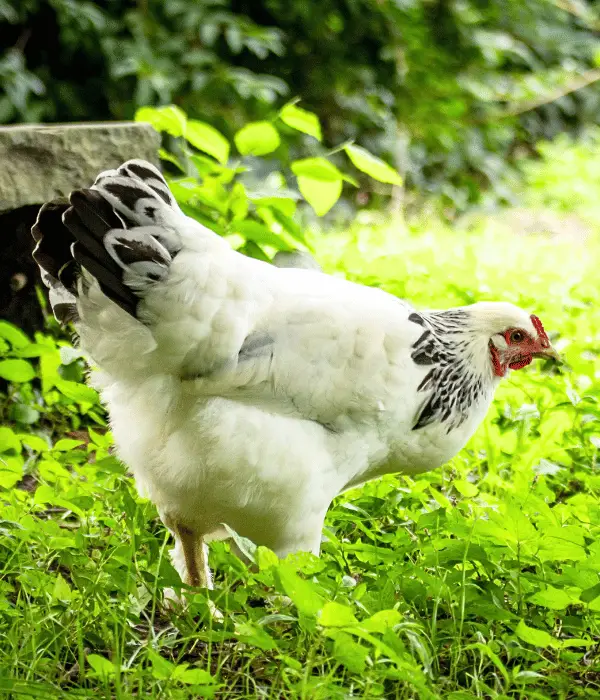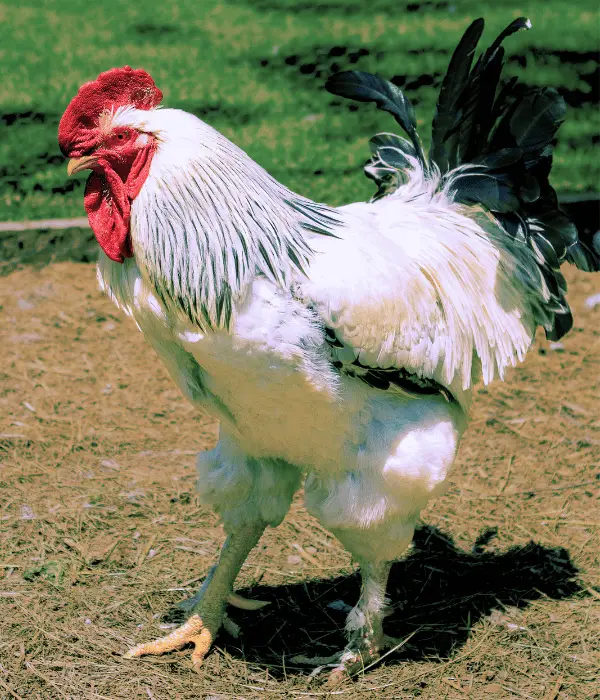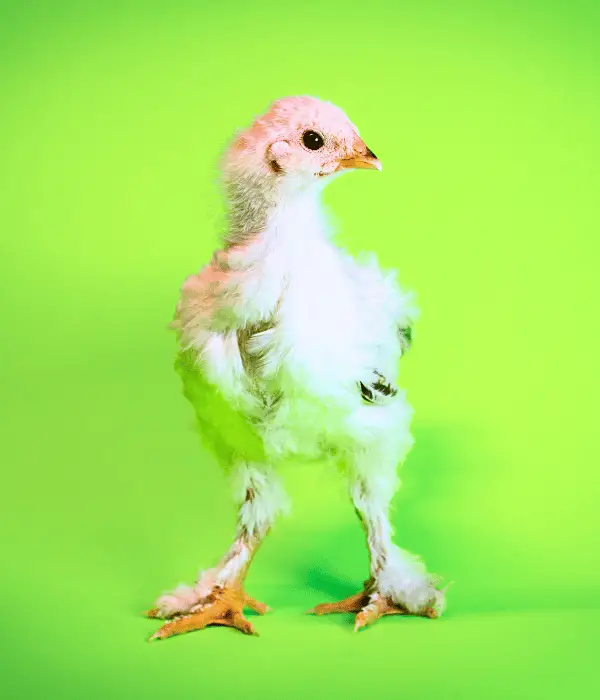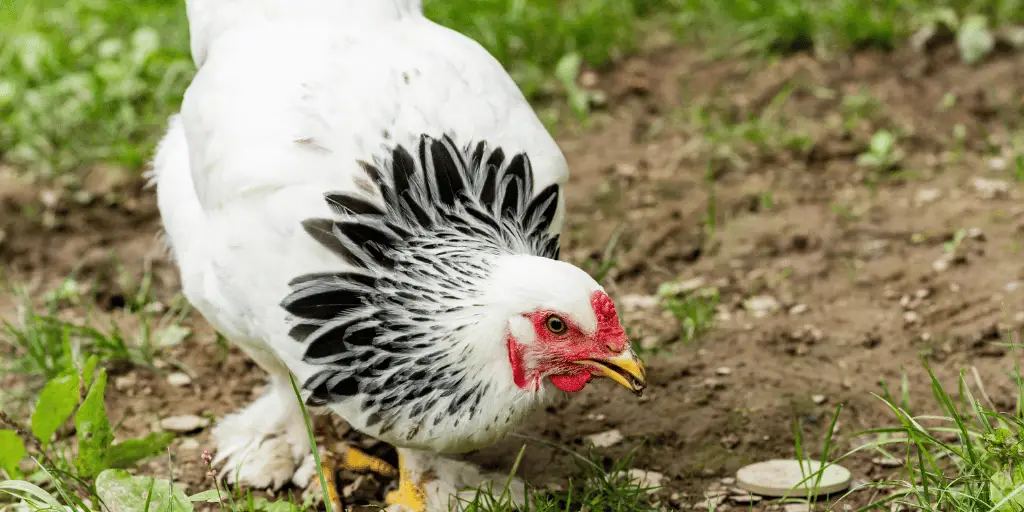The Light Brahma chicken is a beautiful bird with a fascinating history, unique characteristics, and easy-to-care-for temperament.
They make a great addition to any flock, whether you are a beginner or an experienced chicken keeper. It is a variety of well-known Brahma chicken.
Introduction to Light Brahma Chickens
Light Brahma chickens are a heritage breed that originated in the United States in the mid-1800s.
They were originally bred for meat production but became popular among chicken enthusiasts for their stunning appearance and friendly temperament.
Light Brahmas are known for their large size, feathered feet, and gentle nature, making them a favorite among backyard chicken keepers.
History and Origin of Light Brahma Chickens

The Light Brahma chicken breed was developed in the United States in the mid-1800s. They were first exhibited in Boston in 1852 and soon became popular among poultry keepers.
Light Brahmas were highly valued for their large size, meat quality, and ability to adapt to various climates. They were also used as ornamental birds due to their majestic appearance.
The exact origin of Light Brahma chickens is unclear, but it is believed that they were developed by crossing different breeds, including Chittagong, Malay, and Cochin.
The name “Brahma” comes from the Brahmaputra River in India, which was known for its large, exotic animals.
Light Brahmas were first called “Shanghai” chickens, but the name was changed to “Brahma” in honor of their unique heritage.
The Lifespan of Light Brahma Chickens
Light Brahma chickens have an average lifespan of 5 to 7 years, although some can live up to 10 years with proper care. Their lifespan can be affected by various factors, including diet, environment, and genetics.
To ensure a long and healthy life for your Light Brahmas, it is important to provide them with a balanced diet, clean living conditions, and regular veterinary check-ups.
Different Varieties of Brahma Chickens
There are three recognized varieties of Brahma chickens: Light, Dark, and Buff.
Light Brahma chickens are the most commonly kept variety and are known for their white and black feathering.
Dark Brahma chickens have black and gray feathering, while Buff Brahma chickens have a golden buff color.
In addition to these three varieties, there are also Giant Brahma chickens, which are larger than standard Brahmas and come in various colors.
The Temperament of Light Brahma Chickens

Light Brahma chickens are known for their friendly and docile temperament. They are gentle birds that enjoy human interaction and are great with children.
Light Brahmas are also known for their calm and easy-going nature, which makes them a great addition to any flock.
They are not aggressive towards other chickens, making them a great choice for mixed flocks.
Light Brahma Chicken Size and Weight
Light Brahma chickens are one of the largest chicken breeds, with roosters weighing between 9 and 12 pounds and hens weighing between 6 and 8 pounds.
They have a broad, muscular build and are known for their large size and impressive feathering. Despite their size, Light Brahmas are easy to handle and make great pets.
Light Brahma Chicken Egg Size and Laying Habits
Light Brahma hens are good layers, producing large brown eggs. They are not as prolific as some other breeds, such as Leghorns or Rhode Island Reds, but they are reliable layers, producing around 3 to 4 eggs per week.
The Light Brahma hens typically start laying around 5 to 6 months of age and can continue laying for several years.
Light Brahma Chicks (Appearance and Cost)

Light Brahma chicks are adorable, with soft, fluffy feathers and a distinctive black and white striped pattern.
They are easy to find at most hatcheries and can be purchased for around $5 to $10 per chick, depending on the breeder and location.
Light Brahma chicks are easy to care for and make great pets, especially for children.
Raising Brahma Chickens – Housing and Feeding
Light Brahma chickens are easy to care for and require basic housing and feeding needs. They require a secure, dry coop with plenty of ventilation and access to fresh water and food.
Light Brahmas are large birds requiring plenty of space to move around and stretch their legs. They also require a balanced diet of commercial feed, fresh fruits and vegetables, and access to grit and oyster shells for calcium.
Characteristics of Light Brahma Chickens
Light Brahma chickens are known for their distinctive appearance, large size, fluffy feathers, and feathered feet.
They are also known for their friendly and gentle nature, making them a great choice for backyard flocks.
In addition to their appearance and temperament, Light Brahmas are good layers, producing large brown eggs, and are reliable meat birds.
Light Brahma Roosters vs. Hens

Caring for Light Brahma roosters and hens is similar, but there are a few differences to keep in mind. Roosters are larger and more aggressive than hens, so they need more space and a separate area to roost at night.
They also require more protein in their diet, as they burn more calories during mating and fighting. Hens, on the other hand, require more calcium in their diet to support egg production.
Breeding Light Brahmas – Tips and Techniques
Breeding Light Brahma chickens requires some planning and preparation. It is important to select healthy birds with good genetics and to provide them with a comfortable and stress-free environment.
Light Brahmas are known for their broodiness, so they can be raised for meat or as breeding stock. To improve the genetics of your flock, it is recommended to hatch your chicks and avoid inbreeding.
Also read: All about breeding chickens
Health Issues and Diseases of Light Brahma Chickens
Light Brahma chickens are generally healthy birds, but they can be susceptible to certain health issues and diseases. Some common health issues include respiratory infections, mites and lice, and egg binding.
To prevent these health issues, it is significant to provide your Light Brahmas with a clean and dry living environment, a balanced diet, and regular veterinary check-ups.
Frequently Asked Questions about Light Brahma Chickens
What do Light Brahma chicks look like?
Light Brahma chicks have a distinctive black and white striped pattern, with soft, fluffy feathers and feathered feet. They have a distinctive black and white striped pattern, with white feathers on their head and black feathers on their body.
When do Light Brahmas start laying?
Light Brahma hens typically start laying around 5 to 6 months of age.
What color are Light Brahma chicks?
Light Brahma chicks have a black and white striped pattern.
What color are Light Brahma eggs?
Light Brahma hens lay large brown eggs. You may see different brown color variations in their eggs.
How to tell a Light Brahma rooster from a hen?
Light Brahma roosters are larger and more aggressive than hens, with brighter and more colorful plumage. Hens are smaller and have less colorful plumage.
How long do Light Brahma chickens live?
Light Brahma chickens have an average lifespan of 5 to 7 years, although some can live up to 10 years with proper care.
How long do Light Brahmas lay eggs?
Light Brahma hens can continue laying for several years, producing around 3 to 4 eggs per week.
Are Light Brahmas broody?
Yes, Light Brahmas are known for their broodiness and make great mothers.
Conclusion: Why Light Brahma Chickens are a Great Addition to Your Flock
Light Brahma chickens are a beautiful and unique breed that makes a great addition to any flock. They are easy to care for, friendly, and gentle, making them a great choice for backyard chicken keepers.
Whether you are looking for a reliable meat bird or a good layer, Light Brahmas are a great choice. With proper care and attention, your Light Brahma chickens will provide you with years of enjoyment and companionship.


